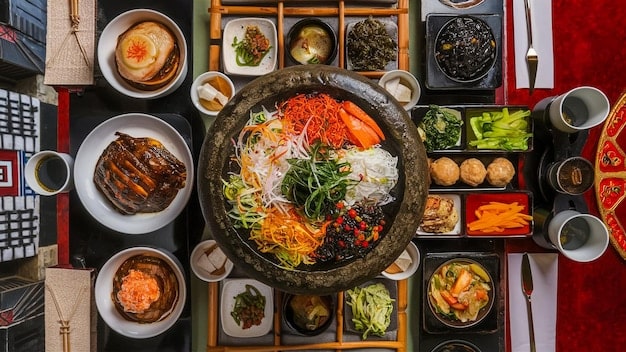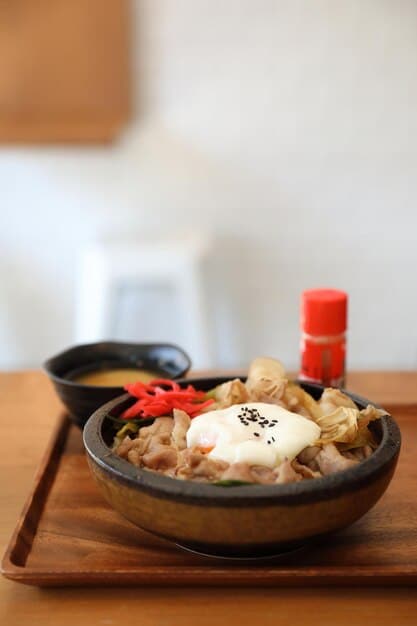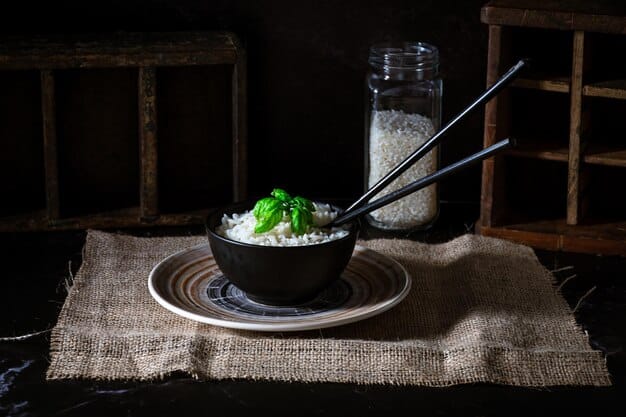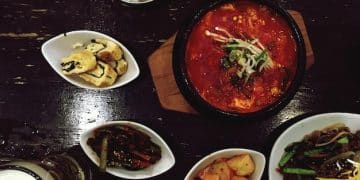K-Drama Food Guide: Recreate Delicious Dishes from Your Favorite Shows at Home

This guide helps K-Drama fans recreate delicious and iconic dishes from their favorite shows, offering practical recipes and cultural insights to bring the authentic Korean culinary experience into their homes.
Ever found yourself watching a compelling K-Drama, only to be completely captivated by the mouth-watering food on screen? From sizzling bowls of ramen to comforting tteokbokki, Korean cuisine plays a central role in many beloved series, adding depth and flavor to every scene. This comprehensive K-Drama Food Guide: Recreate Delicious Dishes from Your Favorite Shows at Home will transport your taste buds straight to Seoul, empowering you to cook and savor the same dishes that bring characters together and drive captivating narratives.
The Allure of K-Drama Food: More Than Just Meals
K-Dramas are renowned not only for their captivating storylines and charismatic actors but also for the enticing portrayal of Korean food. It’s more than just sustenance; food in K-Dramas often signifies comfort, celebration, love, and even reconciliation. It serves as a narrative device, fostering connections between characters and providing a glimpse into Korean culture.
The visual appeal of these dishes is undeniable. Through close-up shots and appreciative reactions from the characters, viewers are left craving the savory, spicy, and sometimes sweet flavors. Understanding this deep connection enhances the viewing experience and inspires many to try and recreate these culinary masterpieces at home.
Cultural Significance on Screen
Many Korean dishes shown in dramas carry profound cultural weight. For instance, the sharing of food, like a communal hot pot or a bottle of soju, symbolizes bonding and intimacy. Eating a warm bowl of jjamppong after a long day at work can represent solace and simple pleasures. These depictions resonate deeply with audiences, making the food an integral part of the K-Drama experience.
- Symbolism: Food often represents emotions, relationships, and societal norms within the drama’s context.
- Community: Meals are frequently shared, highlighting the communal aspect of Korean dining culture.
- Tradition: Specific dishes may appear during holidays or special occasions, reinforcing cultural traditions.
Moreover, the meticulous attention to detail in food styling and presentation elevates the dishes from mere props to characters in their own right, making them globally appealing. The vibrant colors, fresh ingredients, and the way food is consumed on screen contribute to its widespread fascination.
Bridging Worlds Through Taste
For many international fans, K-Dramas serve as a gateway to Korean culture, and food is often the first tangible connection. Recreating these dishes at home isn’t just about cooking; it’s about experiencing a piece of that culture directly. It’s an opportunity to immerse oneself in the flavors and aromas that define Korean households and eateries, as seen on screen.
This culinary exploration fosters a deeper appreciation for the nuances of Korean life, moving beyond the fictional narratives into real-world culinary practices. Whether it’s the simple act of preparing ramyeon or the more elaborate process of making kimchi, each dish offers a unique cultural lesson.
Staple K-Drama Dishes to Master: Your Home Cook’s Toolkit
To truly dive into the world of K-Drama food, mastering a few staple dishes is essential. These are the versatile, comforting, and often iconic foods that appear repeatedly across various series. Developing proficiency in these will allow you to quickly whip up a K-Drama-inspired meal any day of the week.
Having a well-stocked pantry with key Korean ingredients such as gochujang (chili paste), gochugaru (chili powder), sesame oil, soy sauce, and kimchi is crucial. These form the backbone of many Korean dishes and are fundamental to achieving authentic flavors.
Tteokbokki: The Spicy Street Food Star
Tteokbokki, chewy rice cakes drenched in a fiery, sweet, and savory gochujang-based sauce, is arguably the most recognizable K-Drama street food. It’s often seen being enjoyed by characters on a casual outing or as a comforting snack after a stressful day. The texture of the rice cakes combined with the intense flavor profile makes it highly addictive.
- Key Ingredients: Rice cakes (tteok), gochujang, gochugaru, fish cakes (eomuk), green onions, boiled eggs.
- Preparation Tip: Use good quality fish cakes and consider adding a dash of sugar or corn syrup for that signature sweet undertone. The sauce consistency is key; it should be thick enough to cling to the rice cakes.
Its versatility allows for additions like hard-boiled eggs, ramen noodles, or even cheese, making it a highly customizable dish. The communal act of sharing a plate of tteokbokki is a common sight in K-Dramas, symbolizing camaraderie and simple joy.
Ramyeon/Ramen: The Ultimate Comfort Food
Whether enjoyed instantly from a packet, jazzed up with additional ingredients, or served in a bustling restaurant as a more elaborate ramen dish, ramyeon is universally loved in K-Dramas. It’s the go-to meal for late-night study sessions, emotional comfort, or a quick bite between busy schedules. The sound of slurping ramyeon is almost synonymous with K-Drama watching.
While instant ramyeon is a quick fix, elevating it with fresh ingredients like kimchi, soft-boiled eggs, green onions, and even cheese slice takes it to another level. For a more authentic Korean ramen experience, experimenting with homemade broths and fresh noodles can be a rewarding culinary adventure.

Kimchi-jjigae: The Soul-Warming Stew
A bubbling pot of Kimchi-jjigae, a hearty and spicy kimchi stew, is a staple in Korean households and frequently featured in K-Dramas as a symbol of home-cooked comfort. It embodies warmth and a sense of tradition, often shared amongst families or friends during colder months. The fermented tang of kimchi combined with savory pork or tofu creates a deeply satisfying dish.
- Essential Components: Aged kimchi, pork belly (or tofu for vegetarian), soft tofu, mushrooms, green onions, gochujang, gochugaru, anchovy broth (optional).
- Flavor Secret: The older and more fermented the kimchi, the deeper and richer the flavor of the stew. Sautéing the kimchi first amplifies its taste.
Kimchi-jjigae is not just a meal; it’s an experience. The steam rising from the earthenware pot, the vibrant red color, and the robust aroma make it incredibly inviting. It’s a testament to the versatility of kimchi, transforming from a side dish into the star of a comforting stew.
Signature Dishes from Popular K-Dramas: Recreate the Magic
Beyond the staples, certain dishes have become synonymous with specific K-Dramas, leaving a lasting impression on viewers. Recreating these dishes offers a unique way to relive favorite scenes and connect more deeply with the stories and characters. It’s an exercise in culinary homage, bringing fiction to flavorful life.
Each of these dishes often comes with its own memorable on-screen moment, making the act of cooking and eating them even more special. They evoke nostalgia and a sense of shared experience with the characters.
Jjajangmyeon from “Reply 1988” and “Vincenzo”
The iconic black bean noodles, Jjajangmyeon, holds a special place in the hearts of many K-Drama fans. Featured prominently in “Reply 1988” as a celebratory or comforting meal and central to a pivotal scene in “Vincenzo,” it symbolizes coming home, friendship, and even unexpected alliances. The rich, savory, and slightly sweet sauce coating thick noodles is uniquely satisfying.
While buying pre-made jjajang (black bean paste) simplifies the process, crafting your own from scratch takes the dish to another level. The key is in caramelizing the chunjang (black bean paste) effectively before adding vegetables and meat. The slurping of jjajangmyeon is a deeply satisfying and common scene, often portraying a sense of casual comfort or relief.
Chimaek (Chicken and Beer) from “My Love From The Star”
The pairing of crispy Korean fried chicken (Chicken) and cold beer (maekju) – collectively known as Chimaek – gained global fame thanks to “My Love From The Star.” This casual yet incredibly popular combination became a cultural phenomenon, inspiring countless viewers to seek out or recreate this perfect snack duo. It represents indulgence, companionship, and a simple pleasure.
- Chicken Varieties: From classic crispy fried to sweet and spicy (yangnyeom), garlic soy, or honey butter.
- Perfect Pairing: The saltiness and crunch of the chicken perfectly complement the bitterness and carbonation of a cold lager.
Recreating authentic Korean fried chicken at home involves a double-frying technique for ultimate crispness and choosing the right sauce to coat the chicken. The communal aspect of sharing a bucket of chimaek with friends is a beloved K-Drama trope, signifying carefree moments and deep bonds.
Bibimbap from “Boys Over Flowers” and “Crash Landing On You”
Bibimbap, meaning “mixed rice,” is a visually stunning and nutritionally balanced dish often seen in K-Dramas as a wholesome meal. Its appearance in dramas like “Boys Over Flowers” and “Crash Landing On You” highlights its role as a versatile, customizable, and deeply satisfying dish that can be as simple or as elaborate as desired. It’s a harmonious blend of textures and colors, symbolizing balance.
The beauty of bibimbap lies in its colorful array of sautéed vegetables (namul), often including spinach, bean sprouts, carrots, zucchini, and fern bracken, arranged artistically over a bed of rice. A fried egg, seasoned meat (bulgogi or ground beef), and a dollop of spicy gochujang are typically added on top, all to be mixed just before eating. The crispy rice at the bottom of a hot stone bowl (dolsot bibimbap) is particularly prized.
Essential Korean Ingredients and Kitchen Tools
Embarking on your K-Drama culinary journey requires more than just recipes; it demands the right ingredients and tools. Stocking your pantry with key Korean staples and investing in a few essential kitchen items will make the cooking process smoother and your dishes more authentic. Many of these ingredients are now widely available in international supermarkets or Asian grocery stores.
Understanding the nuances of Korean ingredients, especially fermented ones, will significantly elevate your dishes. Authenticity in flavor often hinges on using the correct types of sauces, pastes, and seasonings.
Must-Have Ingredients
These core ingredients form the foundation of most Korean dishes. Having them readily available will ensure you’re always ready to whip up a K-Drama inspired meal, even on short notice. Their unique flavors are what distinguish Korean cuisine.
- Gochujang (Korean Chili Paste): A savory, sweet, and spicy fermented condiment. Essential for tteokbokki, bibimbap sauce, and various stews.
- Gochugaru (Korean Chili Powder/Flakes): Used for spiciness and color in kimchi, stews, and marinades. Available in different degrees of coarseness and heat.
- Doenjang (Fermented Soybean Paste): Earthy and savory, similar to miso but with a stronger flavor. Crucial for doenjang-jjigae and marinades.
- Soy Sauce: Korean soy sauce (ganjang) is typically lighter and less salty than Japanese soy sauce, used for seasoning.
- Sesame Oil: Toasted sesame oil provides a rich, nutty aroma and flavor, used as a finishing oil or in dressings.
- Kimchi: Fermented napa cabbage, an absolute must-have. Versatile as a side dish, or an ingredient in stews and fried rice.
- Mirin (Rice Wine) & Rice Vinegar: Used for marinades, balancing flavors, and removing gamey odors from meat.
- Dashi (Dried Anchovy or Kelp Broth): A foundational stock for many Korean soups and stews.
Sourcing quality ingredients can make a significant difference in taste. Look for “Product of Korea” labels where possible, especially for fermented pastes like gochujang and doenjang, to ensure authenticity.
Essential Kitchen Tools
While not all are strictly necessary, these tools can greatly enhance the experience of cooking Korean food, from preparing ingredients to serving dishes in an authentic way. They often reflect the communal and family-oriented nature of Korean dining.

- Hot Pot/Earthenware Bowls (Dolsot/Ttukbaegi): Ideal for serving bubbling stews like kimchi-jjigae or for making dolsot bibimbap, keeping food hot throughout the meal.
- Korean Metal Chopsticks & Spoons: Distinctly different from wooden chopsticks; long, flat, and made of metal. The spoon is used for rice and soup.
- Large Wok or Deep Pot: Useful for stir-frying, making large batches of stews, or deep-frying Korean fried chicken.
- Mandoline Slicer: For quickly slicing vegetables uniformly for bibimbap or banchan (side dishes).
- Grill Pan or Portable Gas Burner: For grilling meats like samgyeopsal (pork belly) directly at the table, replicating the Korean BBQ experience.
Having the right tools not only makes cooking easier but also adds an authentic touch to your dining experience, allowing you to recreate the visual and sensory aspects of K-Drama meals.
Creative Twists and Adaptations for Home Cooking
While authenticity is often the goal, home cooking also presents opportunities for creativity and adaptation. Not everyone has access to every single ingredient or the time for elaborate preparations. This section explores ways to tailor K-Drama dishes to your dietary preferences, time constraints, or ingredient availability without sacrificing the essence of the flavor.
Embrace flexibility in your kitchen. Learning how to substitute ingredients or simplify cooking processes can make these dishes more accessible for regular home enjoyment, allowing you to enjoy your favorite K-Drama foods more often.
Dietary Modifications
Korean cuisine, while often meat-heavy, can be easily adapted for vegetarian, vegan, or gluten-free diets. Many traditional dishes already have plant-based versions, requiring only minor substitutions. For instance, most stews can be made with tofu instead of meat, and vegetable broths can replace anchovy or beef broths.
- Vegetarian/Vegan: Replace meat with tofu, mushrooms, or plant-based proteins. Use vegetable or mushroom broth instead of anchovy or beef broth. Ensure kimchi is vegan (fermented without fish sauce).
- Gluten-Free: Use gluten-free soy sauce (tamari). Verify that gochujang and other pastes are gluten-free, as some may contain wheat. Rice-based products like tteokbokki are naturally gluten-free.
- Lower Sodium: Opt for low-sodium soy sauce. Be mindful of added salt in recipes, as many Korean condiments are already quite salty.
These adaptations demonstrate the versatile nature of Korean cooking and expand the reach of these delicious dishes to a wider audience, ensuring everyone can enjoy a taste of K-Drama.
Time-Saving Tips and Ingredient Swaps
Busy schedules shouldn’t prevent you from enjoying K-Drama food. There are numerous shortcuts and smart substitutions that can significantly reduce cooking time while still delivering delicious results. The goal is to capture the essence of the dish, even if certain steps are simplified.
- Pre-Marinated Meats: Buy pre-marinated bulgogi or spicy pork for quick pan-frying.
- Instant Broths: Use instant dashi packets or vegetable bouillon instead of simmering custom broths from scratch.
- Frozen Vegetables: Pre-cut frozen vegetables can save prep time for stir-fries or stews.
- Store-Bought Kimchi: Essential for speed, though making it yourself is a rewarding project when time allows.
- Packet Sauces: Some dishes like japchae or jjajangmyeon have convenient pre-made sauce packets that simplify the cooking process significantly.
Even small adjustments can make a big difference in making these recipes more approachable for everyday cooking. The spirit of the dish remains, offering a comforting connection to your favorite K-Dramas.
Beyond the Plate: Enhancing Your K-Drama Culinary Experience
Recreating K-Drama dishes at home is not just about the food itself; it’s about curating an entire experience. From setting the mood to serving your creations, there are many ways to fully immerse yourself in the world that these dramas portray. This holistic approach makes the dining experience truly special and memorable.
Consider the atmosphere, the presentation, and even the company you keep. These elements combine to create a dining experience that mirrors the warmth and emotional depth often seen in K-Drama meal scenes.
Setting the Scene: Music, Mood, and Company
To truly transport yourself to a K-Drama setting, pay attention to the ambience. Play a K-Drama original soundtrack (OST) playlist, known for their ability to evoke emotions and specific scenes. Consider dimming the lights or using soft, warm lighting to create a cozy, intimate atmosphere, reminiscent of a late-night chat over a meal. The company you share the food with also plays a significant role, reflecting the communal ties shown in dramas.
Sharing your home-cooked K-Drama feast with friends or family amplifies the experience, mirroring the camaraderie and bonding witnessed on screen. It’s an opportunity to create your own precious memories over shared laughter and delicious food.
Presentation Matters: Serving Like a K-Drama Character
Korean dining often emphasizes presentation, with multiple small side dishes (banchan) accompanying the main meal. While you don’t need to recreate an elaborate spread every time, serving your dishes in various small bowls and plates can elevate the experience. Using traditional Korean metal chopsticks and spoons also adds to the authenticity.
- Banchan Variety: Even a simple meal can be enhanced by serving 2-3 different small banchan, like kimchi, pickled radishes, or seasoned spinach.
- Individual Servings: Serve stews in individual ttukbaegi (earthenware pots) to keep them hot and bubbling.
- Garnish: Fresh garnishes like chopped green onions, sesame seeds, or a drizzle of sesame oil add a finishing touch and visual appeal, just like in K-Dramas.
The act of presenting food thoughtfully reflects care and attention, making the meal not just an enjoyable culinary event but also a feast for the eyes. It completes the immersion into the K-Drama dining aesthetic.
| 🍽️ Key Dish | 📺 Featured In |
|---|---|
| 🍜 Ramyeon | Almost every K-Drama, especially for convenience or comfort. |
| 🌶️ Tteokbokki | Popular street food in “Weightlifting Fairy Kim Bok-joo.” |
| 🖤 Jjajangmyeon | Key scenes in “Reply 1988” and “Vincenzo.” |
| 🍗 Chimaek | Gained huge fame from “My Love From The Star.” |
Frequently Asked Questions About K-Drama Food
▼
K-Drama food appeals due to its vibrant visual presentation, the emotional and cultural significance it holds within storylines, and its portrayal as ultimate comfort or celebratory fare. Characters’ enthusiastic reactions also make viewers crave these dishes, creating a strong desire to experience them personally.
▼
Many K-Drama dishes, especially staples like ramyeon and tteokbokki, are surprisingly simple and beginner-friendly. While some dishes involve more steps, there are plenty of adapted recipes available that simplify the process without compromising too much on flavor. Starting with simpler recipes builds confidence.
▼
Authentic Korean ingredients can be found at local Asian grocery stores, particularly those specializing in Korean products. Many online retailers also offer a wide selection of Korean food items, from essential pastes and spices to unique snacks and beverages, delivered directly to your home.
▼
Yes, many K-Drama recipes are highly adaptable for vegetarian or vegan diets. Common substitutions include using tofu or mushrooms instead of meat, vegetable broth for meat-based broths, and ensuring kimchi is made without traditional fish sauce. Many traditional Korean dishes are already plant-based friendly.
▼
While not strictly necessary, having an earthenware pot (ttukbaegi) for stews, good quality Korean metal chopsticks and spoons, and a large deep pot for frying greatly enhances the experience. These tools not only make cooking easier but also bring an authentic touch to your Korean dining setup.
Conclusion
The culinary journey through K-Dramas offers a unique blend of entertainment and gastronomic delight. By recreating these iconic dishes at home, fans can deepen their connection to their favorite shows and the rich tapestry of Korean culture. From the comforting warmth of kimchi-jjigae to the fiery kick of tteokbokki, each dish tells a story, inviting you to create your own delicious narratives in your kitchen. This guide aims to equip you with the knowledge and inspiration to embark on that flavorful adventure, proving that the magic of K-Dramas extends far beyond the screen and onto your dinner table.





